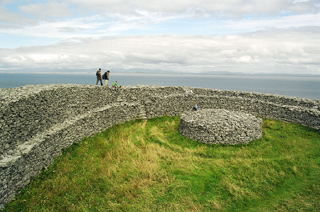Those visiting Inis Mór, the largest of the Aran Islands, take heed: with alacrity, you can improve your visit considerably. As soon as the ferry docks after the forty-five minute crossing, make a bit of a dash for the shop off to the right from the end of the pier, with ‘bicycle rentals’ written in huge letters on the side. For the reasonable price of ten Euros, you get a bike for the whole day (there is also a ten Euro deposit). If you go quickly, you will get one of the nice bikes I saw when I was returning mine in the evening. If you dawdle, you will get a bike several sizes too small and a bit creaky around the edges. I was reminded of the massive water-fights that used to take place in my neighbourhood when I was a kid. Borrowing a bike or a super-soaker of some variety was common, though a good fit in the latter case may not have been.
Over the course of today, I saw both ends of this 11km island (also called Inishmore), and much in between. The bus ride was spent aslumber, trying to make up for the stretched sleep schedule of the past few days. The ferry ride was scenic but unstable. I spent my first half-hour or so on the island profoundly seasick – a condition that is always much aggravated for me when I am tired.
Setting off in a random direction on my diminutive steed, I found myself winding up to the highest point on the island. At the top, there is a tower which you can pay to visit. For free, you can explore the circular fort Dun Eochla. Carrying on in the same direction, you will find a nice sandy beach, then another climb to the fort Dun Aonghasa, which is really quite amazing.
Located at the edge of a 90m cliff atop the crashing waves, this ancient fortress certainly seems as though it would have been easy to defend. I admire whoever has ensured that no fence or railing obscures the view off that great ledge. It is odd, I suppose, how cautiously people treated it. We walk along lethal edges all the time – 10m or so will do it – but when people are presented with something visually stunning, they become much more deferential. In several cases, I saw people lie on their stomachs with their heads about 3m back from the edge, then flop forward until they could see downwards to the rocks and breaking waves.
From Dun Aonghasa, I doubled back to the ferry terminal and then off to explore the other part of the island. Because the way the island consists of a series of hills, riding across it is an alternation between climbing gentle slopes and then coasting down the other side; it makes for a nice mixture of exertion and aesthetic appreciation. 99% of the tourist traffic of cycles and mini-buses goes in the other direction. As such, the northern part of the island is good for getting your fill of fields full of cows and sheep, horses and rabbits, and all other manner of grass-munching beast.
Before leaving, I picked up a very warm and sturdy pair of woolen hiking socks, made from the fibrous coats of the aforementioned sheep. I strongly considered buying one of the excellent looking sweaters, but decided that I wear insulating upper clothing so rarely that it would not be worth the (quite reasonable) price.
I am being hastened off the internet by six pairs of piercing eyes (those of fellow hostel members). Putting up the photos from today will be particularly gratifying, I think. Early tomorrow, I make my return to Dublin.
PS. If someone could find a few photos of those forts and link them as a comment, that would be wonderful. I would do it, but have not the time.


Thanks. Perhaps Cheallaigh would be kind enough to write a little bit about the origins of these places.
Here is Dun Eochla.
And Sun Aonghus.
@RK
Sun Aonghus should be Dun Aonghus